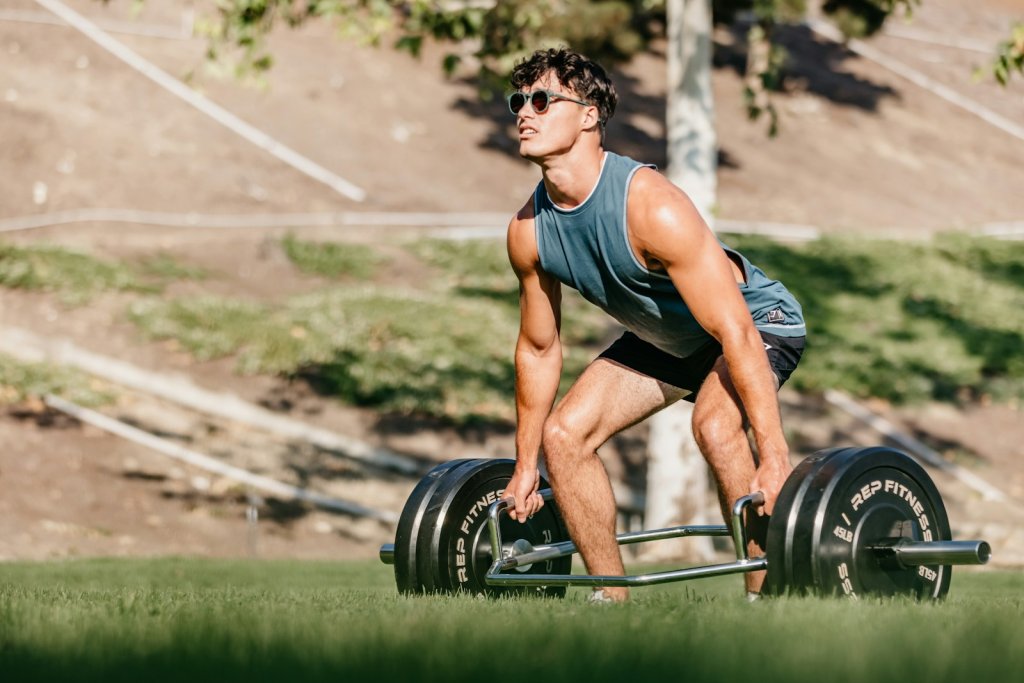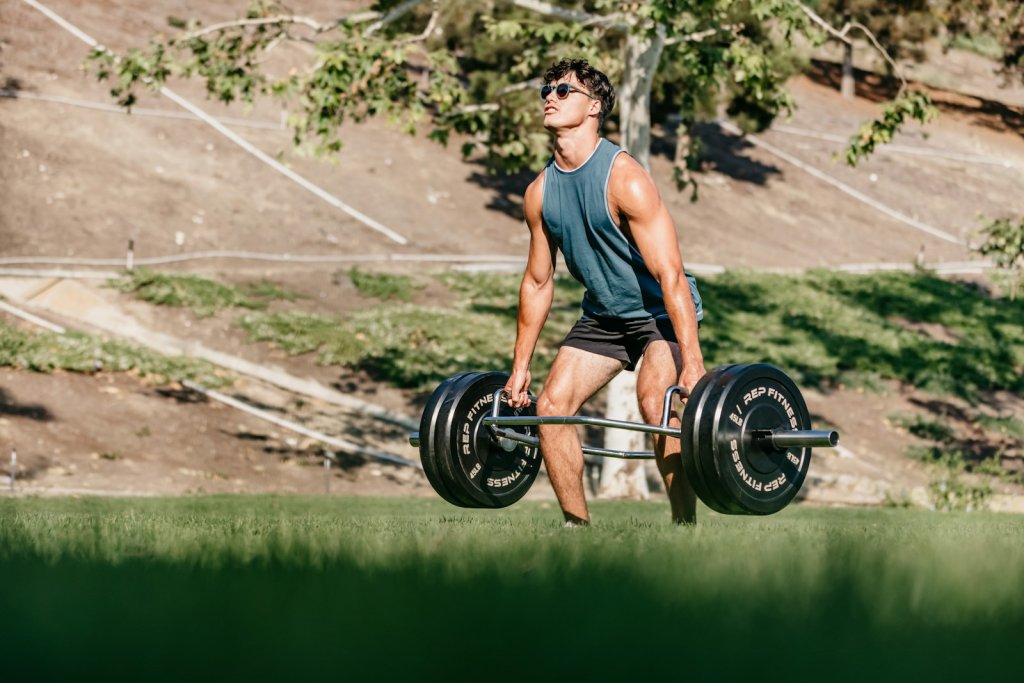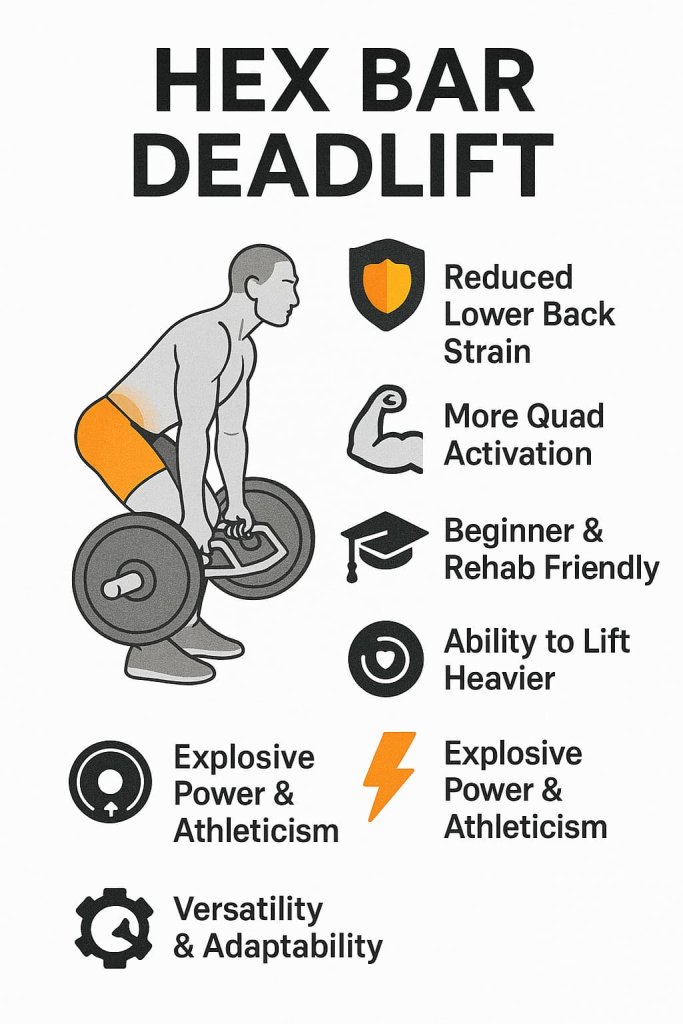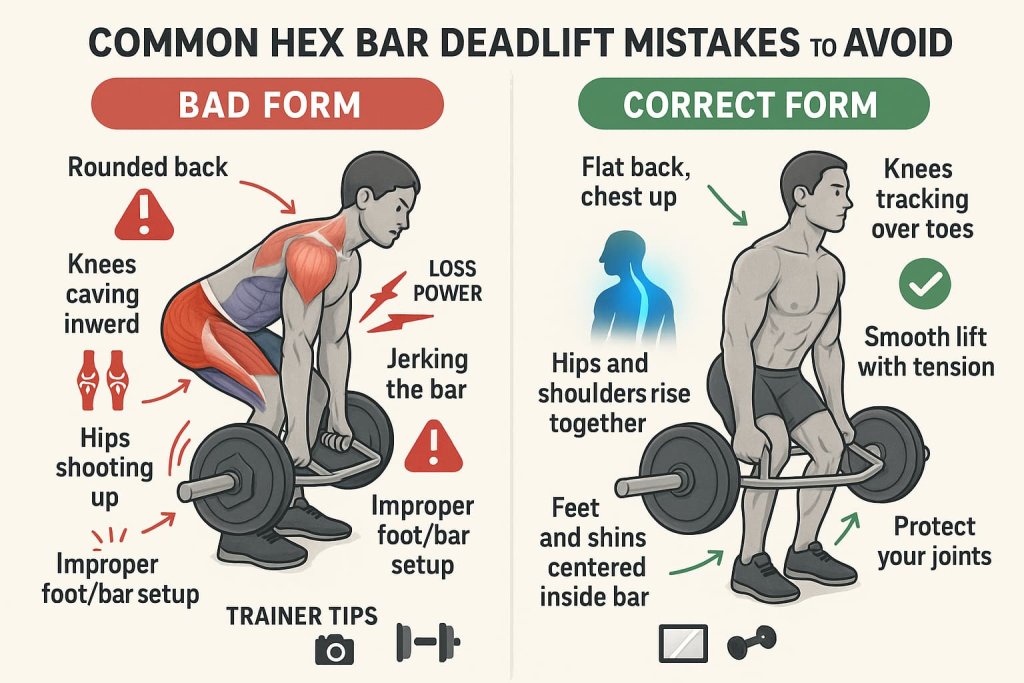The hex bar deadlift is a safe, powerful, and beginner-friendly way to build full-body strength, boost athleticism, and protect your lower back—all while targeting major muscle groups like the glutes, quads, and hamstrings. If you want to master this modern deadlift variation, here’s exactly what you need to know, including proper form, benefits, common mistakes, how it compares to the barbell deadlift, top alternatives, who should do it, and expert trainer tips.

Understanding the hex bar deadlift helps you train smarter and avoid injury—whether you’re a beginner, athlete, or experienced lifter. In this guide, you’ll learn step-by-step instructions, key muscle recruitment, advantages over traditional deadlifts, and much more. If you want a lift that’s both effective and joint-friendly, the hex bar deadlift should be on your list.
What is the Hex Bar Deadlift?
The hex bar deadlift—also known as the trap bar deadlift—is a deadlift variation performed with a hexagonal (or trapezoidal) barbell that you step inside. The handles are positioned at your sides, rather than in front of your shins as in the conventional deadlift. This design shifts the center of gravity in line with your body, creating a safer, more biomechanically efficient lift.

- The neutral hand position reduces wrist and shoulder strain.
- The load is centered, minimizing forward lean and reducing stress on your lower back.
- It allows most people to lift heavier weights with better form and less injury risk.
- The exercise is commonly used for athletes, older adults, and anyone looking for a more joint-friendly strength option.
How to Do the Hex Bar Deadlift (Step-by-Step Proper Form)
- Set Up: Place the hex bar on the floor and step inside so your feet are centered, about hip to shoulder-width apart. Toes point slightly out, and your shins are close to the bar handles.
- Grip and Brace: Bend at your hips and knees (hip hinge), keeping your chest up and back neutral. Reach down and grasp the handles—use high handles for an easier start, or low handles for more range of motion. Squeeze your shoulder blades back and down. Brace your core tightly as if preparing for a punch.
- Lift: Take a deep breath, then drive your feet evenly into the floor. Push the ground away while extending your hips and knees at the same time. Keep your chest tall, eyes looking forward or slightly down. At the top, stand tall with your hips fully extended, glutes tight, and shoulders back but relaxed.
- Lower: Reverse the movement by pushing your hips back first. Maintain a braced core and a neutral spine as you lower the bar to the ground. Once the weights touch down, reset and repeat.
- Expert Form Cues: Imagine “cracking a walnut” with your armpits to engage your lats. Keep your arms straight—don’t pull with your biceps. The bar should travel in a straight, vertical line.
Muscles Worked by the Hex Bar Deadlift
The hex bar deadlift is a compound lift, working multiple muscle groups at once:
- Glutes (gluteus maximus): Powerful hip extension at the top of the lift.
- Quadriceps: Much more activated than in a standard deadlift, especially with high handles or a more upright posture.
- Hamstrings: Support hip extension and knee stability.
- Spinal erectors (lower back): Maintain neutral spine, but less strained than with the straight bar deadlift.
- Trapezius and upper back: Stabilize shoulder blades and bar.
- Core: Provides stability and prevents rounding.
- Forearms and grip: Required for holding heavy loads.
Science Note: A 2023 study in the Journal of Strength and Conditioning Research found that the hex bar deadlift activates the quads more than the barbell deadlift, while also reducing spinal loading. This means more leg strength with less lower back risk.
Key Benefits of the Hex Bar Deadlift

- Reduced Lower Back Strain: The weight is centered, so you can maintain a more upright torso. This reduces shear and compression forces on the lumbar spine—making it safer for your back (Stronger By Science, 2024).
- More Quad Activation: Unlike the barbell deadlift, the hex bar places more demand on your quads (thighs). This makes it a great bridge between deadlifts and squats, helping you build strong, balanced legs.
- Beginner and Rehab Friendly: The neutral grip, easy setup, and reduced technical demands mean it’s easier to learn and coach. It’s ideal for new lifters, seniors, or those returning from injury.
- Ability to Lift Heavier: Research shows many lifters can pull more weight with the hex bar compared to the straight bar. The improved leverage and neutral grip allow you to train heavier and build more strength (Bodybuilding.com, 2024).
- Explosive Power and Athleticism: The trap bar deadlift is popular in sports performance programs because it allows athletes to move weight faster, increasing speed and power for running and jumping.
- Versatility and Adaptability: You can use it for heavy singles, high-rep sets, loaded carries, or even jumps, making it one of the most versatile lifts for all ages and goals.
Common Mistakes to Avoid

- Rounding Your Back: Letting your lower or upper back round exposes your spine to injury. Keep your chest up, brace your core, and flatten your back before you lift.
- Knees Collapsing Inward: Letting the knees cave in can stress the joints and cause poor lifting mechanics. Always track your knees over your toes.
- Hips Shooting Up First: If your hips rise before your chest, you lose power and risk back strain. Make sure hips and shoulders lift together.
- Jerking the Bar Off the Floor: Don’t yank the bar. Build tension in your body first, then smoothly drive upward.
- Improper Bar Setup: Start with feet and shins centered in the bar. Don’t stand too far forward or back.
- Trainer Fixes: Record your lift from the side to check your spine and bar path. Use a mirror for immediate feedback. Start with lighter weights until your form is perfect.
Hex Bar Deadlift vs. Barbell Deadlift
| Feature | Hex Bar Deadlift | Barbell Deadlift |
|---|---|---|
| Weight Position | Centered within your body | In front of your shins |
| Spinal Stress | Less; more upright torso | Higher, especially lumbar region |
| Quad Involvement | More, especially with high handles | Less, more posterior chain |
| Glute/Hamstring | Moderate, varies by setup | Very high, especially conventional |
| Ease of Learning | Easier, beginner-friendly | Technical, harder for tall/beginners |
| Lifted Weight | Most people can lift heavier | Often limited by grip or back strength |
| Powerlifting Use | Rare (not a competition lift) | Essential for competitive lifting |
Which should you choose?
Hex bar deadlift: For safety, athletic training, or if you want to build total leg strength with less risk.
Barbell deadlift: For sport-specific training, maximum posterior chain development, or if you compete.
For deeper science, see Stronger By Science’s Trap Bar Deadlift Comparison.
Top Alternatives to the Hex Bar Deadlift
- Dumbbell Deadlift: Mimics the neutral grip and upright torso; use the heaviest dumbbells you can safely handle.
- Rack Pull: Lifting a barbell from knee-height. Great for focusing on lockout and back strength.
- Sumo Deadlift: A wide-stance barbell deadlift that emphasizes inner thighs and hips, with a more upright posture.
- Romanian Deadlift: Focuses on the hamstrings and hip hinge. Use lighter weights and perfect your form.
- Kettlebell Deadlift: Perfect for learning hip hinge and deadlift technique, even with lighter weights.
- Landmine Deadlift: Uses a barbell in a landmine attachment to create a hybrid between squat and deadlift movement.
Trainer Tip: Rotate through these alternatives to challenge your muscles and keep your training fresh, especially if you experience plateaus or joint discomfort.
Who Should Do the Hex Bar Deadlift?
- Beginners: Easy to learn, less technical, and reduces injury risk.
- Older Adults: Safer on joints and lower back, helps maintain muscle and bone density.
- Tall Lifters: The hex bar accommodates longer limbs, making form easier.
- Athletes: Boosts power, speed, and overall strength.
- Rehab and Post-injury: The neutral grip and upright position support recovery.
- Bodybuilders & Lifters: Great for adding volume and variety, especially for legs and traps.
- Anyone seeking a safe, effective full-body lift!
Trainer Tips and Best Practices
- Start with the High Handles: This reduces the range of motion and makes learning easier. Progress to low handles for more challenge.
- Brace and Breathe: Inhale deeply and brace your core before every lift. This protects your spine.
- Visualize the Movement: Picture “pushing the ground away” with your feet instead of pulling the bar up.
- Maintain Even Pressure: Distribute weight evenly across your whole foot—avoid shifting to toes or heels only.
- Use Progressive Overload: Gradually increase weight, reps, or sets as you get stronger.
- Don’t Neglect Mobility: Warm up hips, ankles, and upper back to ensure safe, powerful lifting.
- Track Progress: Record weights, reps, and how you feel after each session for best results.
Frequently Asked Questions
- Can you replace the barbell deadlift with the hex bar deadlift? Yes, for most lifters, the hex bar deadlift is a safe, effective substitute—unless you’re competing in powerlifting.
- Is the hex bar deadlift safe for lower back pain? It’s generally safer due to reduced spinal loading, but always use perfect form and consult a professional if you have a history of back issues.
- How often should I train the hex bar deadlift? 1–2 times weekly, with at least 48 hours between heavy sessions. Start with 2–4 sets of 5–10 reps.
- Will it build muscle? Absolutely! It’s a proven, research-backed way to grow glutes, quads, hamstrings, and back muscles.
Conclusion
The hex bar deadlift is a science-backed, joint-friendly powerhouse for total-body strength, muscle building, and athletic development. Its unique design makes heavy lifting more accessible for all lifters—beginner to advanced, young or older. Master your form, avoid common mistakes, and use this lift as a cornerstone of your training routine for years of results.
